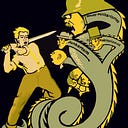The 1956 Anti-Revisionist Protests in Georgia
How thousands of Georgian students and workers opposed Khrushchev’s “secret speech” and foreign policy
On March 9, 1956, the anti-Marxist leadership of the Soviet Union drowned the rebellion of thousands of Georgian workers and youth in blood. The protesters came out against Party revisionism, of which Nikita Khrushchev was the figurehead. Through “critiquing” Stalin, Khrushchev conveniently — and discreetly — rejected foundational Marxist principles and theses, including the theory of proletarian dictatorship, and started purging oppositional Party cadres, who opposed the direction of Soviet economic and foreign policy.
The protests began on the 4th of March, 1956. During the demonstrations, many revolutionary slogans were said and repeated, most of which were directed against the Soviet government and the police. At this point, no one predicted that the demonstrations would turn into riots, but on March 6, the work on “the cult of personality” by CPSU was published in Georgian media, which caused huge backlash. The protests erupted in Gori, Kutaisi, Batumi, Sokhumi and Rustavi.
On March 7, the students of Tbilisi State University refused to attend lectures and moved to Lenin’s Square, where they protested the new politics of the Communist Party. During these events, the leader of the Chinese civil war, Marshall Zhu De was visiting Georgia. The protesters demanded an appointment with Zhu De, so that they could receive his support, as well as of Mao Zedong and Communist China. The number of protesters reached 70,000. The Marxist character of the movement was evident, as also remarked by Russian espionage. The apparent differences between China and the Soviet Union created more tension for the Soviet government, as the masses were moving through the streets chanting pro-Mao slogans. For example, one such famous slogan reads:
“Long live Lenin, Stalin, Mao and Zhu De, long live Georgia, the eyrie of eagles!”*
Soon, the capital of Georgia, Tbilisi, was almost completely paralyzed. Shops closed and factory workers joined the students. The situation was becoming more radical. On March 8, school students, who took part in the demonstrations, lethally stabbed a policeman.
On the tragic morning of March 9, the rebels moved towards the Georgian Post building. As they did not receive specific answers from General Zhu De (he only greeted the protesters, but did not give a speech), they decided to send a telegram to Mao Zedong personally, where they would ask him help in combating Soviet revisionism. The counter-revolutionary Party officials gave authorization to open fire and disperse the people gathered at the post building. According to official Soviet estimates, only 23 people were killed on March 9, but eyewitnesses claimed that the Soviet Army murdered hundreds and wounded even more. The youngest of the victims was a 15 year old schoolboy, Valeri Avalidze.
In the 1960s, the global communist movement divided into two. The revisionist camp, led by the Soviet Union, inside its borders and outside, within its spheres of influence, became the enemy of Marxism and the working class. The anti-revisionist camp was represented by Mao’s China, under whose banner were united some of the most exemplary revolutionaries of the late 20th century. The 1956 protests in Georgia represents a very important chapter in the pages of anti-revisionist resistance against the Soviet Union.
* In Georgian, this slogan rhymes. The original goes: “გაუმარჯოს ლენინს, სტალინს, მაოსა და ჯუ დეს, გაუმარჯოს საქართველოს, არწივების ბუდეს!”, transcribed roughly as “Gaumarjos lenins, stalins, maosa da ju des, gaumarjos saqartvelos, artsivebis budes!”
Sources:
[1] http://www.revolutionarydemocracy.org/rdv5n2/georgia.htm
[2] https://www.youtube.com/watch?v=8BvRoWgk7E4
[4] Andrew M. Smith — “Which East is Red? The Maoist Presence in the Soviet Union and Soviet Bloc Europe 1956–1980”
Additional Literature:
Vladimir A. Kozlov — Mass Uprisings in the USSR: Protest and Rebellion in the Post-Stalin Years
